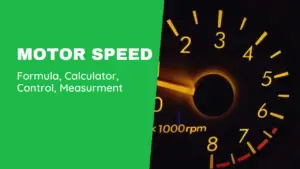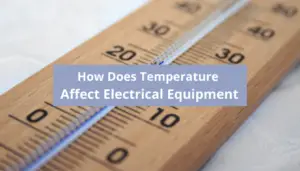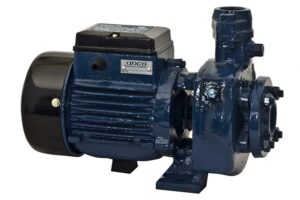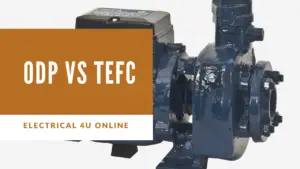I have seen many electric motor burnout accidents in my work. When an electric motor burns out, it affects production and safety.
As an electrical engineer, I know very well that, one of the most important tasks of electric engineers is to keep all assets working safely and properly. What causes an electric motor to burn out? This is a question I will answer in detail.
Table of Contents
The electric motor burned out meaning
When someone says that a motor “burned out,” it means that the motor has experienced a failure due to overheating or excessive stress.
Motors are devices that convert electrical energy into mechanical energy to perform a specific task, such as moving parts of a machine or driving a fan.
A motor can burn out for various reasons, including:
-
Overheating: Continuous operation without proper cooling can cause a motor to overheat. This may happen if the motor is overloaded, the ambient temperature is too high, or if there are issues with the cooling system.
-
Excessive Load: If a motor is subjected to a load beyond its designed capacity, it can lead to increased heat generation and, eventually, burnout.
-
Electrical Issues: Problems such as short circuits, electrical imbalances, or voltage spikes can cause a motor to burn out. Electrical issues can result from faulty wiring, defective components, or power supply problems.
-
Mechanical Issues: Friction, misalignment, or other mechanical problems within the motor or the system it is driving can lead to increased resistance and overheating.
-
Age and Wear: Motors have a limited lifespan, and as they age, the likelihood of failure increases. Wear and tear on internal components can eventually lead to burnout.
When a motor burns out, it often results in permanent damage to its internal components, and the motor may no longer function properly. In some cases, the burnout may be accompanied by smoke or a burning smell.
To prevent motor burnout, it’s essential to operate motors within their specified load and temperature limits, provide adequate cooling, perform regular maintenance, and address any electrical or mechanical issues promptly.
What causes Electric motors to burn out?
Electric motors can burn out due to a variety of reasons, and the specific cause can depend on factors such as the type of motor, its design, and the operating conditions. Here are some common reasons why electric motors might burn out:
-
Overloading: Running a motor beyond its designed capacity or continuous operation at or near its maximum load can lead to overheating and eventual burnout. Overloading is a common cause of motor failure.
-
Insufficient Cooling: Motors generate heat during operation, and if they are not adequately cooled, the temperature can rise to levels that damage internal components. Inadequate ventilation, blocked cooling passages, or a malfunctioning cooling system can contribute to overheating.
-
Voltage Fluctuations: Variations in voltage levels, such as electrical spikes or drops, can negatively impact motor performance. Sudden increases in voltage can lead to excessive current, while low voltage may cause the motor to draw more current to compensate, leading to overheating.
-
Frequent Starts and Stops: Motors experience greater stress during startup due to the surge in current required to overcome inertia. Frequent starts and stops, especially in high-demand applications, can contribute to thermal stress and motor burnout.
-
Electrical Imbalance: Imbalances in the electrical supply, such as uneven phase voltages or current, can lead to uneven stress on the motor windings. This imbalance can cause overheating and eventually burnout.
-
Mechanical Issues: Problems in the mechanical components of the motor or the system it drives, such as misalignment, excessive friction, or bearing failure, can increase the load on the motor and lead to burnout.
-
Contamination: Dust, dirt, or other contaminants can accumulate inside the motor and hinder proper cooling. Additionally, contaminants can cause abrasion or damage to internal components.
-
Age and Wear: Like any mechanical device, electric motors have a finite lifespan. As motors age, internal components may wear out, reducing efficiency and making them more prone to failure.
-
Incorrect Sizing or Installation: Using a motor that is either too small or too large for the application can lead to operational problems. Incorrect installation, such as improper wiring or mounting, can also contribute to motor failure.
To prevent electric motor burnout, it’s crucial to operate motors within their specified conditions, ensure proper maintenance, address any mechanical or electrical issues promptly, and provide adequate cooling and ventilation.
Regular inspections and monitoring can help identify potential issues before they lead to motor failure.
Read my other detailed article on my safetyfrenzy site: Sewing Machine Motor Burnout for more information.
How to Check Electric Motor?
Determining whether a motor is burned out involves a combination of visual inspection, testing, and sometimes using your senses. Here are some steps you can take to assess whether a motor is burned out:
-
Visual Inspection:
- Look for Smoke or Burn Marks: If the motor has recently burned out, there may be visible signs of smoke or burn marks on the motor casing or nearby components.
- Check for Unusual Smells: A burned-out motor often produces a distinct burnt smell. If you detect a strong, unpleasant odor around the motor, it could be an indication of damage.
-
Listen for Unusual Noises:
- Motors often produce specific sounds during normal operation. If you hear unusual noises such as grinding, rattling, or clicking, it may indicate a mechanical issue or damage to internal components.
-
Check for Overheating:
- Feel the motor casing. If it’s excessively hot, it could be a sign of overheating. However, be cautious not to touch the motor directly if it’s too hot, as it could cause burns.
-
Measure Electrical Parameters:
- Use a multimeter to check the electrical parameters. Measure the resistance of the motor windings to see if they are within the specified range. An open circuit or significantly higher or lower resistance than expected may indicate a problem.
-
Inspect Wiring and Connections:
- Examine the motor’s wiring and connections for any signs of damage, loose connections, or burnt insulation. Faulty wiring can contribute to motor burnout.
-
Perform a Continuity Test:
- Check for continuity between the motor windings and the motor frame. There should not be continuity, as this could indicate a short circuit.
-
Check for Mechanical Issues:
- Inspect the mechanical components, such as the bearings and shaft, for signs of damage, wear, or misalignment. Excessive friction or mechanical issues can lead to motor failure.
-
Consult Motor Specifications:
- Refer to the motor’s specifications and compare its operating conditions with the actual conditions it has been exposed. Overloading, incorrect voltage, or other factors outside the specified range can contribute to motor burnout.
If, after performing these checks, you suspect that the motor is burned out or damaged, it may be necessary to replace or repair the motor.
It’s also advisable to consult the manufacturer’s documentation for specific diagnostic procedures and recommendations.
If you are unsure or if the motor is part of a larger system, seeking the assistance of a qualified technician or electrician is recommended.
Signs of electric motor burnout
When an electric motor burns out, it means that the motor has experienced a failure resulting in significant damage, and it can no longer operate properly.
The consequences of a burned-out electric motor can vary depending on the severity of the damage and the specific circumstances, but here are some common outcomes:
-
Loss of Functionality:
- The most immediate and apparent consequence is the loss of the motor’s ability to perform its intended function. The burned-out motor may no longer be able to drive machinery, fans, pumps, or any other equipment it was powering.
-
Smoke and Odor:
- Burned-out motors often produce smoke and emit a distinctive burnt smell. This is due to the damage to the insulation on the motor windings, causing it to release smoke and odor.
-
Physical Damage:
- The internal components of the motor, such as the windings, insulation, and other critical parts, may experience physical damage. This damage can be visible upon inspection and may include melted or charred insulation.
-
Electrical Failure:
- Burnout is often accompanied by electrical failure, such as short circuits or open circuits within the motor windings. This can result in a loss of electrical continuity and prevent the motor from functioning.
-
Potential Fire Hazard:
- In extreme cases, a burned-out motor can pose a fire hazard. The combination of heat generated during the burnout process and the release of combustible materials from damaged components may lead to a fire risk.
-
System Downtime:
- Depending on the application, the failure of an electric motor can lead to downtime in industrial processes or other systems. This downtime can have economic implications and may require the replacement or repair of the motor.
-
Safety Risks:
- If the motor is part of a safety-critical system, its failure could pose risks to personnel or the surrounding environment. For example, a motor failure in a ventilation system could impact air quality in an enclosed space.
-
Repair or Replacement Costs:
- In many cases, a burned-out motor cannot be repaired and must be replaced. The cost of motor replacement, along with potential associated costs such as system reconfiguration or downtime, can be significant.
-
Investigation and Diagnosis:
- After a motor burnout, it’s essential to investigate the root cause of the failure to prevent similar incidents in the future. This may involve examining the motor, conducting tests, and analyzing operational conditions.
To mitigate the risks associated with electric motor burnout, it’s crucial to operate motors within their specified conditions, perform regular maintenance, monitor for signs of trouble, and address issues promptly.
Regular inspections, monitoring of temperature and vibration, and adherence to proper operating practices can help extend the life of electric motors and reduce the likelihood of burnout.
How to protect the motor from burning out?
Protecting a motor from burning out involves implementing various preventive measures and adopting good maintenance practices. Here are some tips to help protect an electric motor from burning out:
-
Proper Sizing and Selection:
- Choose a motor that is appropriately sized for the application. Avoid overloading the motor, and consider factors such as torque, speed, and duty cycle during the selection process.
-
Voltage and Current Monitoring:
- Regularly monitor the voltage and current levels to ensure they are within the motor’s specified operating range. Sudden spikes or drops in voltage can lead to motor stress and burnout.
-
Maintain Proper Cooling:
- Ensure that the motor has adequate ventilation and cooling. Keep air passages clean, and make sure cooling fans or systems are functioning properly. Overheating is a common cause of motor burnout.
-
Temperature Monitoring:
- Use temperature sensors to monitor the operating temperature of the motor. If temperatures exceed recommended levels, it may indicate a problem that needs attention.
-
Avoid Frequent Starts and Stops:
- Minimize the number of starts and stops, as these phases can subject the motor windings to additional stress. Soft-start or variable frequency drive (VFD) systems can help reduce the stress during startup.
-
Balance Three-Phase Motors:
- Ensure that three-phase motors are properly balanced in terms of voltage and current across the phases. Imbalances can lead to uneven stress on the motor windings.
-
Regular Maintenance:
- Establish a routine maintenance schedule that includes inspections, lubrication, and testing. Regular maintenance can help identify potential issues before they lead to motor failure.
-
Check Insulation Resistance:
- Periodically measure the insulation resistance of the motor windings. A decrease in insulation resistance can indicate the onset of insulation breakdown, which may lead to burnout.
-
Protect Against Voltage Spikes:
- Install surge protectors or voltage stabilizers to safeguard the motor against sudden voltage spikes or fluctuations.
-
Monitor Mechanical Components:
- Regularly inspect mechanical components such as bearings, couplings, and belts for signs of wear or misalignment. Mechanical issues can increase the load on the motor.
-
Use Thermal Overload Protection:
- Install thermal overload protection devices to trip the motor if it exceeds safe temperature limits. This can prevent overheating and burnout.
-
Ensure Proper Lubrication:
- Keep bearings and other moving parts properly lubricated. Inadequate lubrication can increase friction, leading to overheating and motor failure.
-
Address Electrical Issues Promptly:
- Address any electrical problems, such as loose connections or damaged wiring, promptly. Electrical issues can contribute to motor burnout.
-
Train Personnel:
- Ensure that personnel operating and maintaining the motor are adequately trained to follow proper procedures and recognize potential issues.
By implementing these measures, you can significantly reduce the risk of motor burnout and prolong the lifespan of the electric motor.
Regular monitoring, preventive maintenance, and prompt attention to any signs of trouble are key components of a successful motor protection strategy.




